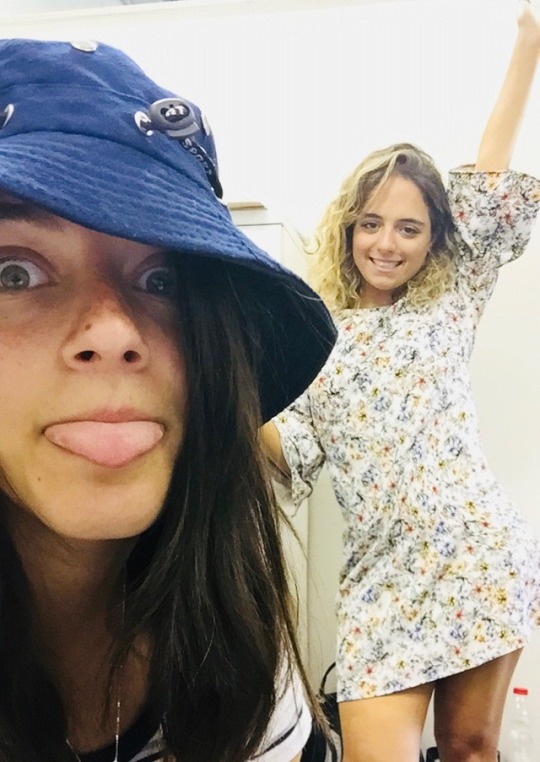Text
WWTAD?
What would the architect do?
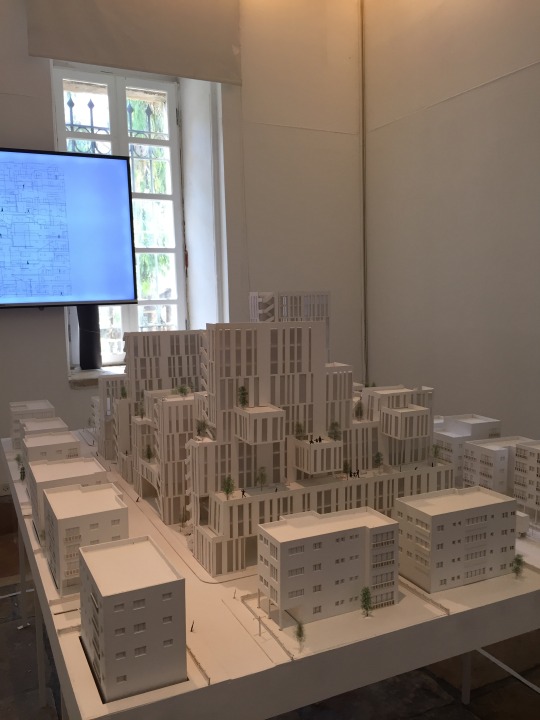
What up everyone - just another hot sweaty day in Jerusalem - what about you?
Today I went to the Bezalel Art School Architecture Senior Thesis Exhibition with Tamir Manzur. Let me tell you something, these kids are talented af. (Well actually they’re not even kids because they all did their army service and this is the end of a 5 year program... lol.) Each room had different projects that were all focused on something different. Some were created alone and others were group projects of 2 students. They each had laser cut models and some even came with a video presentation next to them. The basis for these projects were based on real life places that the student decided to research and further develop based on their owns ideas for the spot. Some focused more on the conceptual, some on the practical, and others on huge projects that would take a lifetime to build if they ever came to fruition.
Being with Tamir was very helpful because he studied Architecture and Urban Planning at the Technion Institute in Haifa, Israel. His experience and knowledge in the field gave me the opportunity to critique the students projects in a manner I wouldn’t have been able to do on my own. He pointed out inconsistencies, gave constructive criticism and explained why he loved some of the projects in particular. I was able to see them through his eyes. He also brought his adorable 2 month old son which made it that much more interesting haha!
Seeing the floor-plans, perspectives, elevations and models reminded me yet again why it is that I love architecture and design so much. Just like we mentioned in previous posts the ability to change the world through design, planning and architecture based on the needs of the people is something so incredibly satisfying and will give anyones life a sense of accomplishment and happiness... besides all the stress hehe.

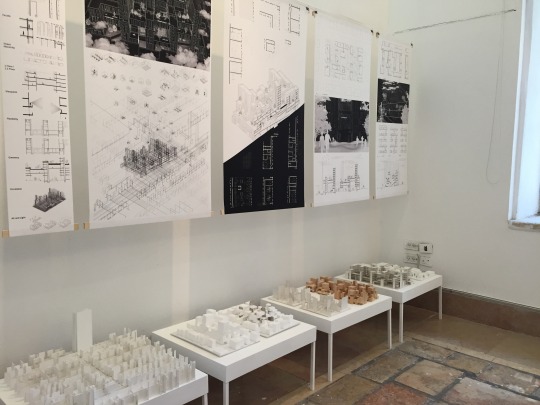
#art#architecture#urbanplanning#bezalel#jerusalem#interns#models#floorplan#elevation#perspective#exhibition#thesis#stress#sweaty#impressive#proffesionals#summer#onward#SummerInJerusalem#sij
0 notes
Text
Celebrity Sighting

Last week from an outsiders perspective it would look like, based on our excitement, we had ourselves two celebrity sightings in one day. In normal peoples lives, celebrity tends to be a term used to describe some Instagram famous model à la Kardashian. However, having the lives of urban planning and architecture interns changes the meaning of the word. We had the chance to sit down with two very inspirational, impressive, successful experts in their field. These people define what it means to put your work first, be successful, and strive to work for the people to make the world a better place. Our amazing boss, who’s more like a sister at this point lets be real, @Maya Tapiero where ya at, has so many amazing connections to people she is able to put us in touch with to meet to help determine and learn in what path life can take us, how we can direct it and why or where we should be focused in order to achieve what we want in this lifetime.
Go on #ImListening....

First we met Dana Gazi. At the age of 41, Dana has recently opened a private firm with a small handful of partners. Dana is possibly one of the busiest people in Jersualem, and we managed to track her down and get a quick run through of her journey from Kabbalah to the Gay Pride parade. We met in her office, an intimate and inspiring environment, beautifully decorated with style and work in mind. While Dana is currently in the process of getting her masters in Urban Planning, she received a bachelors in Jewish studies, specifically focused on Kabbalah (mysticism), then continued to study Social Work. When looking for a job, she turned to the municipality who said, “we need an urban planner, heres your job”. With no prior knowledge or background in the field, Dana was was completely thrown into the situation. Despite this she always put 200% of herself into her work. She worked as a Community Planner in Kiryat Yovel and Givat Ram for 5 years, always quick to learn on her feet. She described herself as someone who, while over the years has calmed a little, is always ready to fight her way to get her message across. She is the perfect Community Planner in that way, as she sees a need for the people and has the ability to give them a voice. Through her work there she found a need to focus on public participation. She saw that the only way to help the people was to hear the people and make them feel heard. She explained that the BEST outcome happens if you can hold many conflicting ideas and messages that you’ve heard from the people within your mind, and form them into something great.
---Our faces when we try to get on her level and do just that---
#ComeAgain?

Her final project before moving to the private sector came from seeing an ignored need. The city had been planning to double the amount of residential buildings in the already over populated area. She and her now partner, (forget his name woops) came to the committee with concerns. They saw that this would ruin not only the environment but the quality of life in the area. The committee, in turn, essentially said “if you think its so bad, you find a way to do it.” The two had three months to come up with an entirely new plan. So, they hit the ground running. With that focus on public participation in mind, they spent a month and a half interviewing anyone and everyone. They then used all this information to not only come up with a new plan, but include documents and regulations that would need to be applied. In the end, 90% of their plan was used. After this success, Dana and her partner saw not only their own potential, but the potential of the people. They opened their firm which works with companies and governments alike to work with the people for the people...
Some of her firms most recent projects include organizing programming for Pride Month in Tel Aviv, tapping into her instinct for connecting with people and focusing on public participation to make it one of the most successful Pride Months the city has ever seen. Her team is also working on a new green and sustainable street on General Pierre Koenig street in the neighborhood of Baq’a in Jerusalem with benches, greenery, and pops of color to make it beautiful and fun! One of the issues she raised that’s close to her heart, is that many immigrants want to move to Jerusalem and in order to do that area needs to be rebuilt and in effect becomes much more densely populated. But, there are already so many housing projects and residential areas that need to be improved, that don’t get a steady supply of water or are in desperate need of a basic sanitation upgrade, that neglecting to help those people is wrong. She is continuously and tirelessly working this angle with hopes to have a better future for everyone.

After being blown away by our meeting with Dana, we were lucky to meet with an equally impressive Greek architect by the name of Elias Mesinass. A master of all trades, I think the simplest thing to say about him is that he studied architecture and sustainability in Israel and at the Yale University in Connecticut. While originally from Greece, Elias is constantly involved in different projects. The edited list he ran through included everything from working as a Urban/Community Planner for the German Colony in Jerusalem, to traveling back to Greece to help in synagogue restorations and architecture, programming and organizing Eco-week in Jerusalem, teaching in Holon and Sde Boker and, in collaboration with a landscape designer, helping to redesign the outdoor garden of the Nature Museum next to the municipality in the German Colony, where his official office is. While technically he is working part time for the municipality, it is truly a full time job. Its fascinating that he is willing to extend himself this much and take all this on because he is so devoted to doing what he does and making the world a better place through architecture and design.
Does putting mirrors on all the facades count as making the world a better place? .. it is very conducive to taking better pics... but people inside can definitely see every pose we strike... #awks

A crucial point he made is that design and architecture are so much more than the magazines. A lot of professionals will design in order to get their work into a pretty magazine. But truly caring about what the world and the people need is not about making it into a magazine. Whether your project is big or small, Architecture, Urban Planning, Sustainability and Design are all fields in which at the end of the day you feel accomplished having made even a small difference wherever you are, its not about fame or recognition at the core. He learned a lot of his theories from an Egyptian architect, Rass Al Hatri, that he met once in his youth on a class trip. He said at the time he didn’t understand the architects words and that they only made sense years and years later. To Elias’s understanding now what the architect said meant to go around and look at the communities, talk to the people, see the areas that need improvement, find out why, research how, and start there. This is one of the pieces of advice he left with us.
While doing research for this internship, we came across something called the “Creative Class”. The creative class is a term that basically categorizes a group of professionals working in the field of the arts or design and separates them from another category of professionals working more in the realm of business, administration and health care. Richard Florida, the man who created this term and used it within his vernacular states that “along with problem solving their (Creative Class) work may entail problem finding”. This idea ties in very well with the concepts Rass All Hatri told Elias Messiness. This statement is at the very core of what is corrupting the professional world of architecture, urban planning, and design. If the main focus is to create new problems, who will focus on the ones that already exist? It is similar to what Rass and Dana both said. There are people, communities and areas in the world that need improvement, that are living below what is considered a healthy standard of living. So when professionals look to design for the sake of getting featured in that magazine its usually very possible that they will neglect to focus on the real issues at hand. Thankfully more and more often contemporary architects and planners see the importance of public participation. They enrage the communities to help themselves, and they do everything they can (ideally) to help those communities. They do this by considering the inhabitants and people using the spaces when they design and to do their research to learn from previous mistakes of others planners. Unfortunately, this practice was only been brought to the spotlight in the late 20th century. If any of you have ever read Jane Jacobs book of “The Death and Life of Great American Cities”, you will see that this wasn’t always the case.

While telling us exactly what path to take, what to study and where to learn, is something neither one of these people could explicitly tell us, hearing how they ended up where they are and what drove them there was eye opening. As you can see, one of them was thrown into a new situation and made the best of it and is now a mover and shaker in her field. The other went down the path he was interested in but is constantly evolving and taking on new projects that stretch into a plethora of different disciplines that, contrary to popular belief, are all very important aspects of this field of work. This world is huge and if you make the right connections and are passionate about what you want to do then you will get there and whatever it is you end up with will be meaningful. The best advice we can give to you as well as ourselves is to learn as much as you can. Pay attention to every conversation, because everyone has something to teach you. Take in every sight, ask every question and meet everyone you can. The most influential and successful people are the ones that are able to find their passions in seamlessly tying together many different disciplines in harmony.
Someone call TMZ because suffice to say, this was probably some of the most meaningful and interesting celebrity sightings to date.
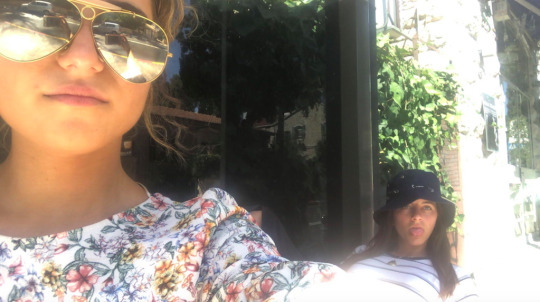
also #sweatyselfiesofc
#intern#israel#urban#planning#Architecture#jlum#jeru#pride#celebrity#jerusalem#influence#community#life#future#coexsist#welovehashtags
0 notes
Text
The Game Changer

Miri Reiss is a healthy city coordinator of Jerusalem. While she has her hands in many projects, she is currently heading the SUNRISE Jerusalem team. Yesterday I got the chance to sit down with her and hear about her life, advice and perspective.
The road to her current position was long and winding. While one in her position is usually expected to have a background in the medical and health sector (nurses or doctors etc.) Miri studied geography in school, and then got a masters in urban planning, preservation and urban development. She worked for many years at the employment authority of the municipality, eventually leading the organization. While she had no medical background, her skills and strong foundation in promoting projects within communities and her familiarity with socioeconomic issues and challenges that different communities face gave her an edge.
When they considered her application for her current position these factors were all considered. Her background helped her bring new perspective to the healthy city realization. Miris expectation for the job was originally was to simply promote healthy cities and the ideals behind these theories. The reason she chose healthy urban planning is not because of what she learned but what she experienced in her professional life. Her experiences working with the unemployed and within communities and urban planning all contributed to her belief that it is all holistic. Every piece is connected and effects each other. To have a healthy civilization every piece that interacts within the society from the buildings themselves, to the layouts of the streets and so on must facilitate that goal.
Miri is working on promoting healthy urban planning project with the healthy city network. It is all a team effort. She and her team do much of the ground work work, and she has connections with the researchers that help connect her to information she needs. Through her work, Miri is combining the fields of urban planning and health and connecting experts in the field. In Israel the connection between health and urban planning is somewhat new. The research and advocates always existed, but they did not attend to all the factors that Miri and her co-workers now strive to include in an ideal world. Even now, when public health nd urban planning are almost always paired together in cities around the world, it can be difficult. There are some factors and initiatives that quickly gain support, while there are others which have difficulty convincing the government and public of their importance. It's all a part of the game, and Miri is a pro.
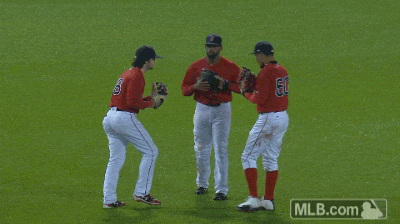
Advice: Mires #1 piece of advice was to find afield that you are passionate about. She asked how can we (Jerusalem) as a city promote people realizing their own potential. While Miri was interesting to interview on many levels, (This one sentence I found extremely profound. It hit precisely the core of what I find intriguing and important about this field of work. Not only do people in these positions have the ability to see the potential that an environment can hold, but they have the ability to help the environment facilitate the realization of this potential! This is what I find so amazing about urban planning. If you are someone who sees the potential in others, and wants to be able to foster growth and change, this is the field for you.) Another key piece of advice- if you want to make change, you need to be in the political game. So batter up.

0 notes
Text
Come Down my Path
What defines a courtyard? My first thought is a paved square lined with nice greenery and trees, a few benches, a water fountain here and there, maybe a decorative statue or sculpture… A place where people like to meet up and spend their time! This is what I’ve been researching and designing for the past 2 weeks. (Here is an example of one of the successful pathways in the area we are trying to recreate).
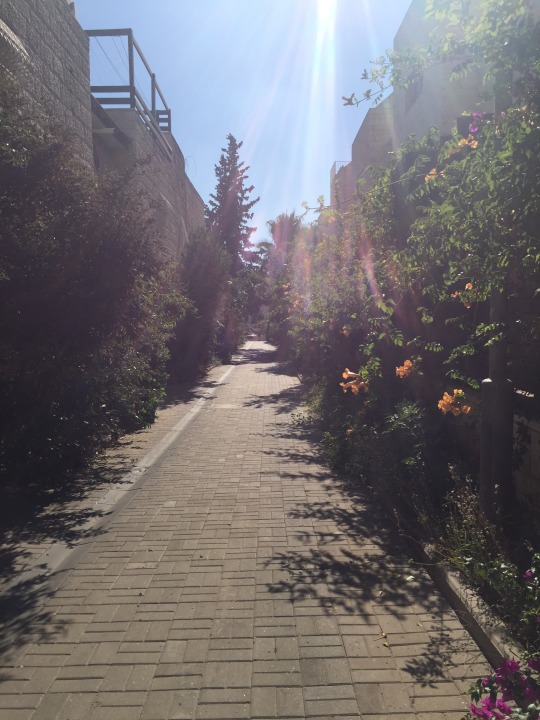
One of the projects I’m working on is focused on observing and mapping out the courtyards and pathways of Ramot Bet. I’ve spent many an afternoon walking through the streets of Ramot Bet, with ma boss @Maya Tapiero where ya at, off of Aaron Eshkoli street. Some of these courtyards are obviously defined, with a square in front of a building complex. However, with only one bench, some abandoned toys and barren of anything green, I’d hardly call this a "place I’d want to meet my friend for lunch”, as google puts it. Others are only defined because of the amount of activity they contain. One such example is a long stair case that sits outside in the center of a few different buildings. It is accessible from all of them as well as opens up into parking lots and the main road at the top of the staircase. But it is not a traditionally defined courtyard..clearly. Would you still call it a courtyard? Or is it just a centralized accessibility ramp? Maybe it’s just a missed staircase thats flooded with little children all the time. Maybe it’s just a place for me to conduct my research and complain about the heat….
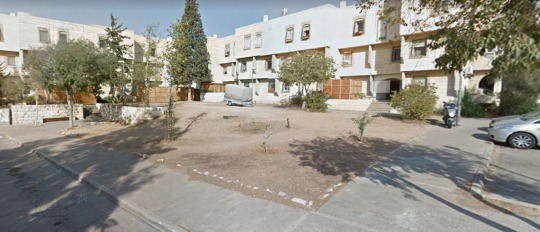
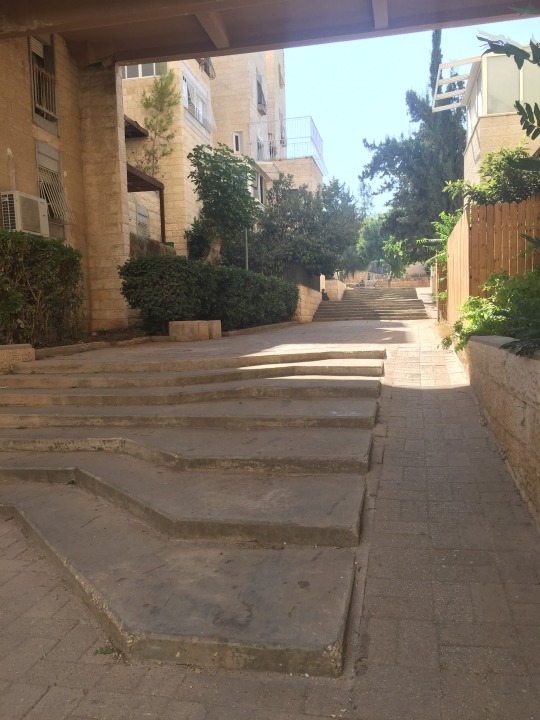
The pathways are usually connected to these courtyards and trickle off into smaller ones on privately owned home streets. For my assignment I specifically chose one or two of these courtyards with a few pathways that are connected in order to beautify them. Part of the issue is that the residents all have different opinions and concerns regarding the maintenance of their public/private areas. Some don't care too much about the appearance of their neighborhood and others do. A lot care more about functionality and the religious education that their children receive, and also live with the bare minimum if you know what I mean. So one of the challenges Im faced with is convincing these specific residents that adding affordable, beautiful, green and structural options to their yards will not only improve the aesthetic of their neighborhood but also affect their quality of living. Emotionally and physically. Together with the residents that care about these matters hopefully we will start to input change.
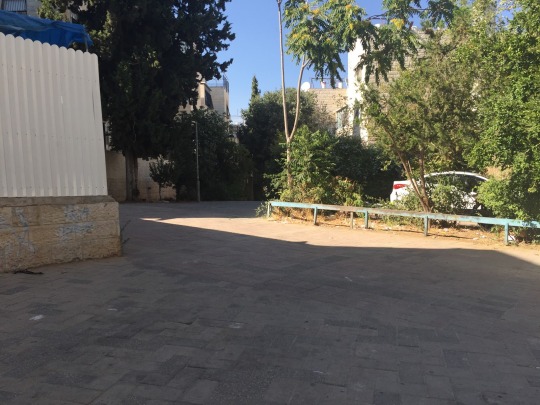
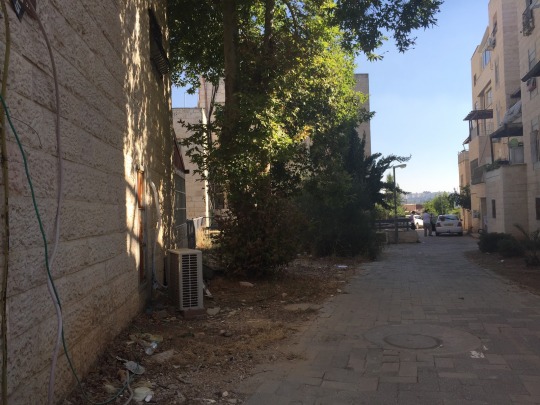
I went to the Botanical Gardens of Jerusalem earlier this week, and did some digging around in their greenhouse conservatory. This is where anyone can come and buy plants, irrigation systems, and soil coverings. But I went to conduct some interviews and pick the brains of the employees there that could help me understand the budget and maintenance required for such a feat. The men that I spoke to were very nice and very smart and spoke almost perfect English - yasss. (Even though I have a ways to go with my Hebrew and need to practice with every chance I get… oh well).I came back with all this information and put together a slide show that we are going to show to the residents this week in order to figure out how much they are able to give to something like this. My hope is to boost their confidence and feelings so that they know they are able to afford to have a beautiful neighborhood and it is something they CAN afford to care about.


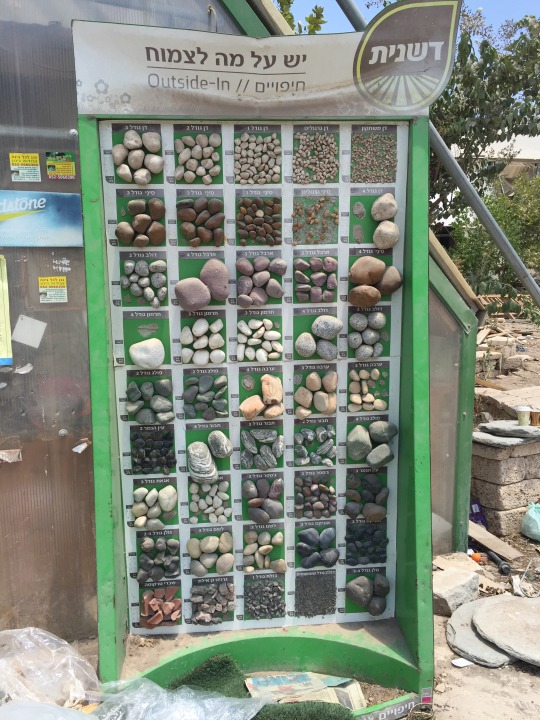
PeaceLoveCoexsist
#intern#urban planning#architecture#beauty#sunburn#botanical#gardens#courtyards#pathways#summer#orayta#onward#irrigation
0 notes
Text
Sunrise and popsicles
Interning for a community city planner in Jerusalem means a few things. First, it means you will never spend the day sitting in one office. Waking up everyday I have the expectation of being on at least one bus at a random time of the day, and of going on at least one tour of a new neighborhood. Because of this, the second thing to note is that your work will spread throughout the city. While my main area of interest this summer falls in Baka, I have spent days in the Ramot neighborhood learning about the work going on there. The third thing to note, which might be more of a life lesson, is that chocolate and popsicles can cure just about anything.

My work in Baka began at the Jerusalem city hall building on Jaffa Street. Past the famous concrete pillows, I entered building 4 of the city hall which hosts the environment and sustainability departments of the municipality. Here, a small team of urban planning and community experts is working on a large scale EU project: SUNRISE. The SUNRISE project is a grant facilitated by the EU’s Horizon 2020 programme in which six cities around Europe work to develop strategies for greener cities based on their communities’ needs and their municipality’s abilities. The hope is that after successfully developing these initiatives with the local communities, the cities will be able to learn from their experience, as well as from the experiences of the other city partners in SUNRISE. The overarching goal is to develop a structure that advances green initiatives throughout cities worldwide.
Jerusalem chose to focus on the established and growing community of Baka. Baka is a residential neighborhood that sits between the industrial Talpiot and the rest of the city. When I first heard this, I was surprised. I had grown up knowing Baka to be a pretty area with lots of wealthy olim and Anglos (people that move to Israel and speak english.) I then remembered, the point of the program was not only to help the community, but to see what could make an initiative like this successful in order to apply it to other neighborhoods. While SUNRISE provides funding and support, it does not provide enough funding to develop a neighborhood from the infrastructure up. In order to determine how to implement the program, it is best done on a strong yet malleable slate. While the other city partners had to focus on building the community infrastructure in addition to their green initiative, Baka was chosen in part due to its pre existing infrastructure and active community. The goal of the Jerusalem project is to enable walkability in the area and inspire everyone from children to their parents to teachers and seniors to make walking a more significant part of their daily lives. The initiatives that are being worked on to encourage these goals include a walking to school program, as well as the upgrading of a regularly used walking path known as The Green Path.
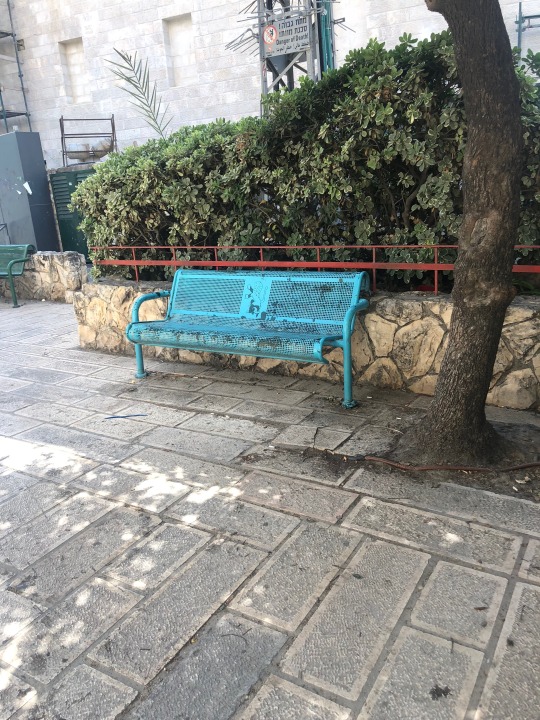
(Photos of The Green Path area that is currently in the process of being upgraded)
As a student, any chance to work with people on a professional and expert level is both exciting and intimidating. Walking into the building 4 office was different from any experience I’ve had in government offices. Basically, the people in the office are the best of the best. They are as hardworking as they are fun, and I still can't tell if its an Israeli thing or those who work in this specific office, but everyone is relaxed and friendly. The project managers not only answered every question I had due to the language barrier (meaning every five seconds they turned to translate something for me,) but they took the time to explain every aspect of the project.
I had the opportunity to sit in on an EU phone call and hear from the project managers of other cities. While I am focusing on the determinants of success for Jerusalem, it was awesome and super interesting to hear from the other project managers. Not only did I get an inside look as to where each city was at in the project, but I got an inside look at how each project manager thought about the process. It was also cool to see which questions they asked each other and what points they picked up on in each cities project- for example, in Malmo they are currently struggling with promoting sustainable mobility in a neighborhood with heavy gang violence. The violence keeps people off the streets, which presents a significant challenge to the Malmo SUNRISE team. The project manager form Israel picked up the challenging context and applauded the team for doing important work in this difficult area. I think this may be because of the periods of violence that are a part of Jerusalem’s history, making the Jerusalem manager more sensitive and aware to the challenges of such a situation.
The next day we met with Lev, a public space projects manager who is working on a platemaking enterprise on the Green Path for SUNRISE and the Jerusalem Municipality. He is working on two seating areas of The Green Path, which is an axis through the Baka neighborhood that, while a bit run down and not totally accessible to senior and people with special needs, could be very useful in promoting walkability. The overall aim in SUNRISE, which is also the agreed-upon vision of Baka residents, is to connect the various segments of the Green Path into a distinct boulevard through the neighborhood. This would not only connect its neighboring areas (Talpiot, German Colony etc) but it would also join up many public use buildings situated on the Green Path including two schools that are working as partners on SUNRISE. Watching the way Lev and Racheli (shoutout!) spoke about the different design possibilities, and how to intertwine both accessibility, aesthetics and financial feasibility was such an interesting experience coming from an IR and public health perspective. The amount of design necessary to be both functional and to support public health principals is so important and is something I never had hands on experience with before.
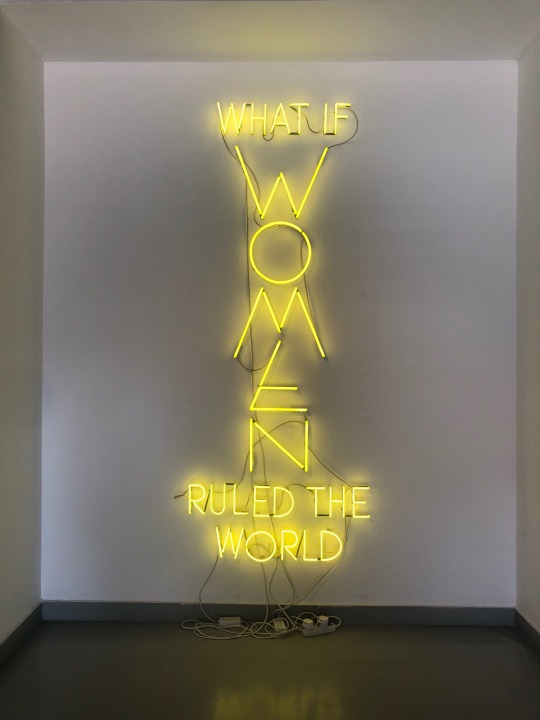
(A piece from the Museum on the Seam)
While we’ve been doing all of the above, we’ve also been touring the city. We visited the Museum on the Seam, a museum that holds exhibits based on political and human rights issues. When we visited the exhibit it was on feminism and displayed art relating to themes of female empowerment vs oppression.
(My impressions on the exhibition to follow in upcoming blog posts...)We have been hiking through the city streets taking note of urban platemaking techniques and projects, the differences in street layouts and designs, and attempted to guess which land is private and public based on its upkeep (re:Public Open Spaces vs Private Open Spaces). We also visited Bezalel’s Masters program in Urban Design final project exhibit, and much more. Throughout it all we’ve been sweaty, happy and probably eating a popsicle or chocolate.
#Urban#Planning#bezalel#masters program#museum on the seam#israel#interns#SUNRISE#jeru#jlum#jerusalem#baka#ba'qa#onward#onward israel#design#place making
0 notes
Text
H(arch)en My Words
On my daily commute, to my awesome internship, with the most amazing boss @MayaTapiero where ya at, I travel along a looongg road called Derech Chevron /də-ˈrā-(ˌ)ch ˈshev-rən/.
First, I pass an Arab neighborhood called Abu Tor. In the image below you can see a pink balcony design of some of the residential apartments in this area. Right away I see a mixture of gothic, Syrian and catholic design in the details of this balcony. The trefoil of each spade is what stands out the most as Catholic/European renaissance influenced design. Then, surrounding each trefoil spade component is an arch which combines, in my opinion, both Gothic revival (because of the point in which the top comes to), but even more so a Syrian/Arabian aspect which is showcased in the curvy and sensual element of it as well. It is v pleasing to look at and I think its cute that they chose to do it in pink which adds a nice contrast to the plethora of Jerusalem stone beige tones that is seen basically everywhere in the entire country.
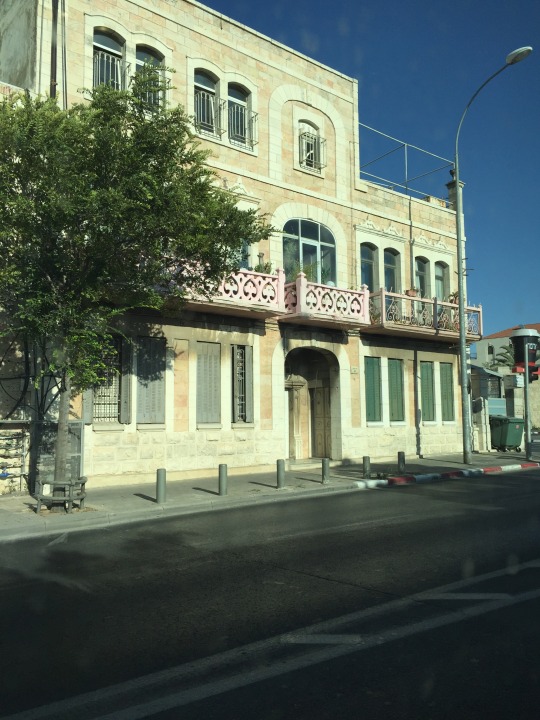
On the same road, closer to the Jewish neighborhood of Baq’a, I saw this similar yet different design of another balcony. This design showcases quatrefoil detailing surrounded by a circle. Right away the contrast between this one and the last is obvious - there is no Syrian/Arabian element here. Here, I only see the Renaissance/Catholic revival, but with an added element of Roman influence that is created, in my opinion, by the circles.
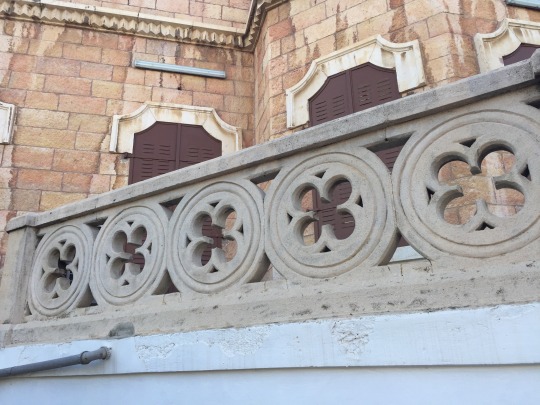
On Agron street, leading towards Mamilla Mall in the City Center, a Jewish neighborhood in the opposite direction of Baq’a, I captured an amazing picture #braggingrights of the Palace Hotel that, to me, reveals the intricate combination between Syrian, Gothic, Renaissance and French architectural design. According to jewishvirtuallibrary.org, this hotel was designed by a Turkish architect and built by 1 Arab and 2 Jewish contractors in 1928-9. Together with around 500 other workers it is a mixture of Greco-Roman, Renaissance, Gothic, Romanesque, neo-Moorish, and Mamluk elements (I was so close lol). This eclectic structure was one of the most luxurious buildings of Jerusalem at the time. Ironically, this is meant to showcase Arabic architecture - which is shown in the engravings of the Quran that adorns the facade and entrance to the hotel - even though today it is in the center of a predominantly Jewish neighborhood. Inside there are additional Art Deco and Greek stylization elements. I think it’s beautiful, the combination of these two cultures in this area is spectacular and something to strive towards in all areas of the country, even where there is the most conflict.

It is fascinating to see the ways in which the cultural planning, architecture and design has sprawled out of the Old City since the deep historical analysis we gave in our first blog post. Told you we needed to start with that post - it totally sets a backdrop for everything else that we’ll analyze in Jerusalem.
#jerusalem#architecture#design#roman#gothic#arab#jewish#culture#hotel#history#coexsist#urban#intern#peaceinthemiddleeast#blog#jeru#jlum#study abroad#art
0 notes
Text
Old City, New Perspective
When studying Jerusalem, there is no better place to start than in the Old City.
About a kilometer squared in area, the walled in Old City that -fun fact- originally made up the whole of the City of Jerusalem now acts as a religious, political and social hub. As new interns we went on a free walking tour offered by Sandeman Tours at the entrance to the Old City by Jaffa Gate (highly recommend btw). While we have both been lucky enough to live in the Old City, this tour gave us a unique opportunity to speak to and learn from the perspective of a certified tour guide. Um, hello Maya and Racheli, what have you been doing there till now...?! Yea, we get it..
If ya didn’t know the Old City of Jerusalem currently holds four quarters: The Muslim, Christian, Armenian, and Jewish quarters. Our tour began outside Jaffa Gate, from which we headed into The Armenian Quarter…

Not so far away from Israel, in a land between Turkey and Georgia, sits Armenia. The Armenians that have been living in the Old City for centuries are predominantly of Christian faith and consider their quarter to be a subsection of The Christian Quarter. Though the Armenian Quarter is small in size and population, with around only 500 residents, they feel very connected to the land because they’ve immigrated here for religious reasons as well as to seek safety from the Armenian Genocide in the Ottoman Empire during the early 1900s. (Why so many genocides people come on.) On our tour we visited mostly residential buildings which were easily identifiable by the last names we saw at their doors. If you’re wondering what little identifier can help with Armenian names, think KardashIAN. The “ian” at the end of a name makes it pretty obvious that the person is Armenian. Most, if not all of the architecture in this quarter resembles those in the other quarters in addition to also having its own architectural landmarks and historical structures. However, it is easy to see when you have crossed over into the next quarter... The Jewish Quarter.

With a little under 3,000 residents, the Jewish Quarter is rich in both history and contemporary life. Between 1948 and 1967, the Jewish Quarter was under Jordanian control, and the Jordanian government did little to explore or develop the area. However, after Israel annexed East Jerusalem in the 1967 War AKA the 6-Day War the first thing the government did in this area was dig, research and develop.
We observed both the excavations and modern day life that exists there (which included multiple face-plants because of the slippery stone floors), one can see the layers of development, planning and improvement that have taken place. Discoveries include the fortification walls, AKA the Cardo, around the ancient old city that were built in order to withstand the Assyrian siege around 701 BC. The ruins of the Cardo indicate the ancient layout of the Roman market that ran through the quarter millenia before any of the restaurants we see now existed. Dayum.
Today a main draw of going through the quarter is to reach the Western Wall, AKA The Kotel, a holy site to many religions. To the Jews it is the last standing piece of the Second Holy Temple, and people come from all over the world to pray at this spot. Throughout the Old City, but especially in the Jewish Quarter, are many lookouts in which you can see The Golden Dome, the most current structure on top of the Temple Mount. The Jewish significance of the Temple Mount dates back to when Abraham was told to sacrifice his son Isaac in this spot as a test of allegiance to God; according to Jewish tradition, it’s also thought to be the point from which the universe was created! Two Jewish temples have stood on the Temple Mount; the first built by King Solomon and destroyed by King Nebuchadnezzar with the Babylonian army; the second built by King Herod and destroyed by King Titus with the Roman army. The history is so intense!
When looking at the Temple Mount today from any of the many viewpoints in the Quarter, you can see the huge platform King Herod built in order to expand the foundation of Har Moriah, AKA the Temple Mount, so that he could build a more glorious Second Temple. That is why the excavations of the Hizkiyahu tunnels next to and underneath the Western Wall are so far down underground. You can see all the archeological layers of earth and the aqueducts that are there, which represent the level at which ancient villages and life existed at a particular time. It’s like going back in time..! Similar to these layers of earth, over the centuries, each layer of history has added up to reach what we call today ‘ground level’.
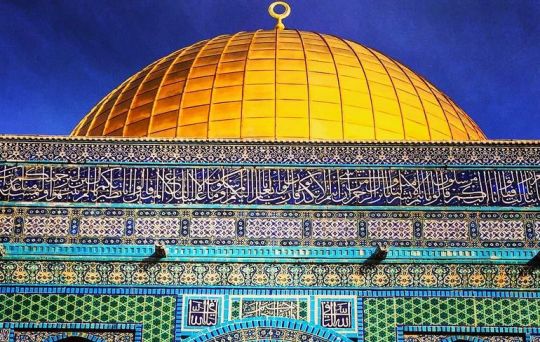
Continuing through the Muslim Quarter’s narrow alleys, past its market filled with stalls of merchants selling jewelry and spices, and down more slippery slopes, we reached a viewing point that overlooks the Western Wall. From this view we saw the whole expanse of the wall including the the Dome of the Rock and the Al-Aqsa Mosque which lies behind it. In Islamic culture the Dome of the Rock signifies one of their three most holy sites. It is believed to be the spot in which Mohammed came to from Mecca on his flying horse to receive the 5 pillars of Islam and from where he then returned to Mecca in the same night. Taking a closer look, you can see a plethora of arabesques and geometry simultaneously and seamlessly working together to create the pattern that is easily recognizable today as classic Islamic design. They additionally create a juxtaposition that is meant to signify that the Quran is organized and should be read and followed as a guide to living life similar to the Indian Kamasutra, Jewish Torah, and Christian New Testament. The building of the Dome of the Rock was initially completed in 691 CE, however the first structure collapsed and so had to be rebuilt 1023, which is what we see today. Food for thought… why did it collapse? Considering all the politics and religious tension what would happen if it collapsed again today…?
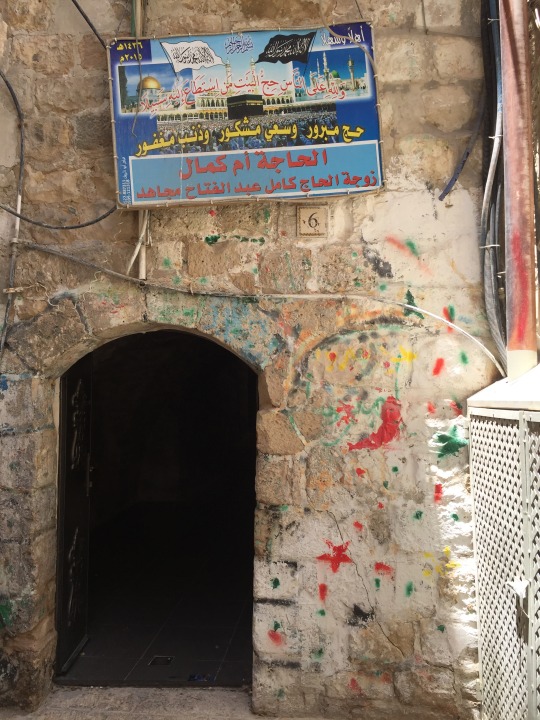
After this we walked to and stopped in front of a Muslim home. A poster hung from the arch above the door. On it were images of the 3 holiest sites in Islamic culture: the Kaaba, the Dome of the Rock and the Al-Masjid an-Nabawi. A Muslim family hangs this poster by their home after they have visited all 3 sites, completing the Hajj, and they are given a tremendous honor for doing so. They are symbolically knighted, and given a term signifying their journey that is added to their last name. In addition to hanging this poster it is common to see a picture of the face of Saladin who is a prominent figure in their history, the Ayyubid Sultan who led the army that defeated the Crusaders in 1187. Muslims that live in this area are very proud of their local history as well as the aesthetic that has developed.
Interestingly from an urban design and planning point of view, the Arab shuk that lines the main roads within the Muslim Quarter was not intentionally planned out , but it seems to have simply developed organically over time based on local needs and culture. . Now its beauty and intricacies have made it into a destination, drawing tourists from all over the world.
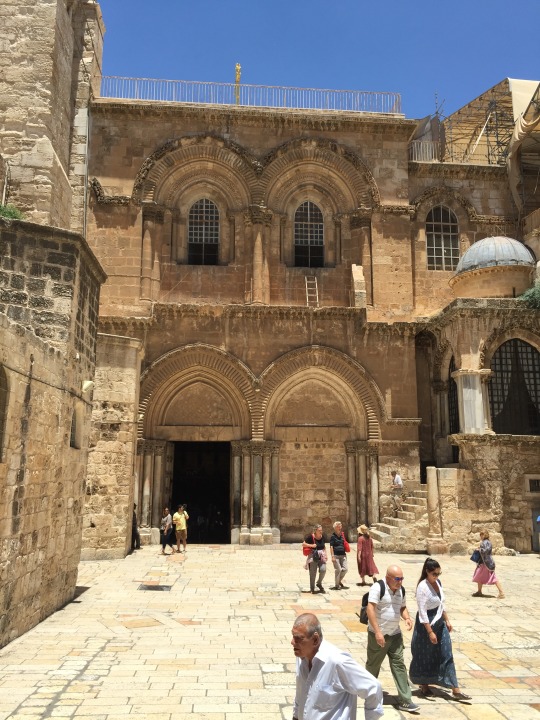

Last but not least, and although small in population size, the Christian Quarter holds over 40 holy Christian sites and landmarks – woah. The most important of these is the Church of The Holy Sepulchre. It is one of the holiest places in the world to Christian tradition. Inside is the site where Jesus was crucified, and the empty tomb which is said to be where he was buried and then rose from. While it is the headquarters to the Greek Orthodox Patriarch of Jerusalem, control of the church is split between several sects of Christianity due to historic tensions over control of the Holy Land (see for example the history of the Crimean War). Part of why nothing ever changes within or around the church - take for example this famous ladder that has stood for years on a ledge outside of the church) is that all involved sects must agree on the change, and the process by which one would need to get that unanimous approval is essentially impossible.
The story goes, when Muslims were in charge of Jerusalem they got hold of the key to the church; in recent times, the various Christian sects couldn’t agree on who would recieve the key, and so there is a neutral East-Jerusalem Muslim family who comes every morning for generations to unlock the church. Seeing the way in which this quarter developed over the centuries, and how eventually the religious and political tensions brought in a neutral third party to help solve sensitive problems, is super interesting. This story shows how all can benefit from this complex space even if it is filled with intra-religious tensions. You should really come check it all out for yourself...
The tour, though a little hot, was a perfect way for us to begin our summer. As our aim for the summer includes understanding Jerusalem in everything from the layout of its streets to the energy that emanates from its residents, it would be impossible to fully grasp the city if we did not start at its roots. Walking the streets of the OG city helped us to fully understand how and why the city has become the place that it is today. We saw the centuries of trial and error and viewed the pieces, now artifacts, that once made up the life of the city, and that continue to do so in an amazing way.
#ISRAEL#URBAN PLANNING#URBAN#city#old city#intern#internblog#onward#onwardsisrael#interns#college#students#Boston#New York#Holy land#holy#excavations#city life#ancient#architecture#dwell#jeru#jtown#jerusalem#orayta#architectur#summer
0 notes
